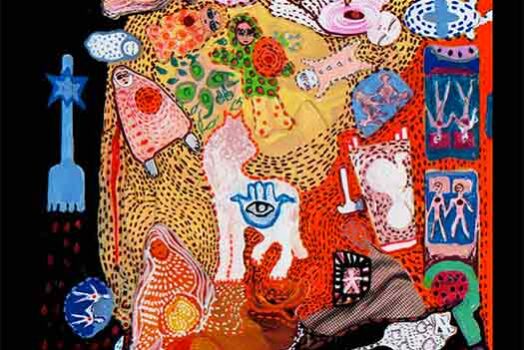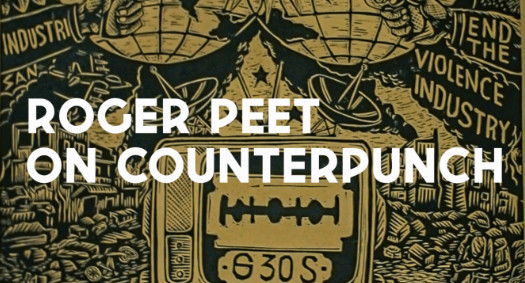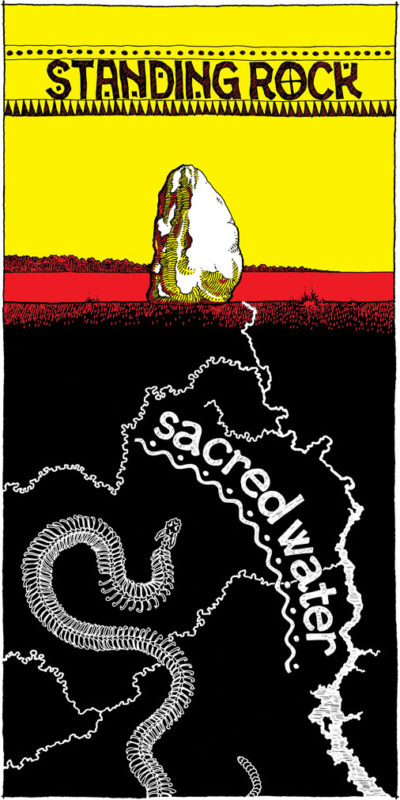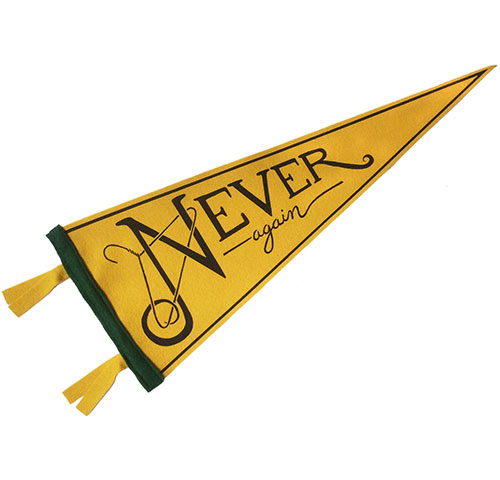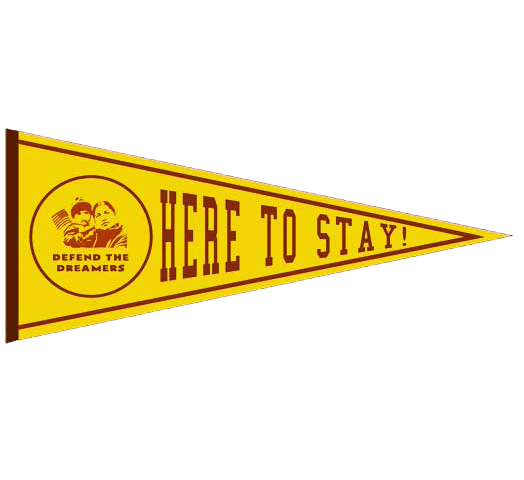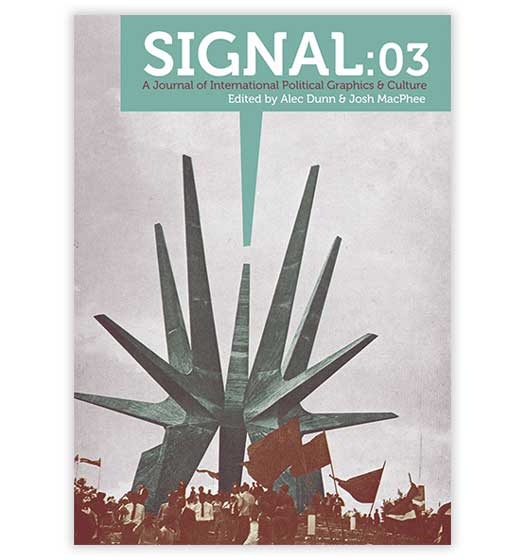
We’d like to know about your background and what has inspired you to make political art.
I grew up in Vancouver, Canada in a conventional family where my mom worked in the home and my father worked at the post office. There was nothing particularly artistic minded about it. But I did have a much older brother who was involved in 60s radical politics, which gave me access to underground newspapers and alternative music from an early age. Following the heroic stories of the civil rights and anti-war movements (over 50,000 Americans fled to Canada to avoid the draft) gave me a life long inspiration for the struggles of social justice. This combined with a natural love of drawing and playing guitar led me to want to express myself with politics and art in the same breath.
When I was a teen, I did cartoons and graphics for a youth liberation publication out of Ann Arbor called FTP Magazine. This was over a period of several years. After high school I went to art school briefly, but found it all too slow. I already knew what I wanted to do in life, so I quit and joined a collective putting out the international anarchist journal Open Road. I did page design, wrote and illustrated/designed full colour centre spread posters. One of my favorite designs was of Emma Goldman (it was later re-printed in Germany). I tried to approach graphic design with a boldness in line and colour that reflected the desires and positiveness inherent in working for a better world. I tried not to be drab and predictable.
I followed this with countless posters for political events and groups. This being the late 70s, early 80s I also did album designs for political minded punk bands like D.O.A. In the mid-80s I formed the underground rock duo Mecca Normal with Jean Smith. From the early 90s I designed community theatre posters, and also book covers for progressive and alternative minded publishers.

I paint, I draw cartoons and illustrations, write books, do graphic design (t-shirts, postcards, posters, books) and play guitar and write music in a rock duo.
I approach all these areas of my artistic work with the same aesthetic sense. The same thinking process that goes into planning a set list or a guitar riff is also there when designing a page in a book or doing a painting or a cartoon. The use of white space in a design is similar to the use of silence in a piece of music or between tracks on an album. The dynamic of spatial relationships whether soft or loud (music) or bright or somber (colour) can be applied to either sound or visuals. This leaves the mind to think of the colour of sound and the sound of colour.
So this means a consistency of style is developed. It acts as a springboard for creativity that then has its own limitations just waiting to be broken. It gives a necessary friction to the creative process. The more I am limited, the more I want to push those limitations, to break those boundaries. It leaves the creative process open to endless possibilities. My work then is in a combined state of building and growing. This is vital to avoiding aesthetic stagnation and increase longevity as a cultural activist.
What is it like to collaborate with your bandmate Jean Smith?
Jean Smith brings a dynamic artistic and personal inspiration to our partnership with a focus and vigor I have rarely encountered. She is always full of exciting ideas and approaches to the creation of art, music and words. To be friends and bandmates with someone for 20 years feels in itself an amazing reality, yet to also be working with a person you highly respect as a novelist, songwriter and painter, well life just doesn’t get any better.



What issues do you address in your work?
My artwork has often concerned the social dynamic between men and women; as well as militarism; social justice; poverty; prisons; pop culture; media and the general state of an often-insane world.
What kinds of responses have you received from people?
Responses vary of course, and as an artist you have to roll with that. It is healthy not to let any response go to your head whether it is good or bad. Though, overall what you remember is when people tell you personally how something you’ve created affected them in a positive way.
How did the “Inspired Agitators” project get started, do you put the posters up on the street, distribute them to community groups, or schools?
“Inspired Agitators” is a series of posters (and postcards) based on the actions of a selection of international activists whose vision and determination inspired me. The series includes John Heartfield, Mordechai Vanunu, Daw Aung San Suu Kyi, Victor Jara for a total of 17. History is embedded with obstacles that must have seemed insurmountable. Yet, again and again, battles are waged in climates of indifference, hostility and brutality. This collection represents inspired moments in history when an Indian Nation wore down the U.S. government, an artist defied the Nazi party, women achieved the right to vote, a socialist government was elected in North America, universal healthcare was implemented, a union for all was organized, a woman was finally accepted legally as a person and a black man fought public lynching.”
After many years of creating posters that were meant to be up as temporary street posters I wanted these posters to be more permanent. So they are treated more as art prints and printed as necessary using computer technology that allows for unlimited colour usage that was previously not possible financially. So wherever Mecca Normal performs in North America we try and put the posters up (as well as our other art) in settings not normally known for political posters. The poster of Paul Robeson was also printed conventionally as part of Josh MacPhee’s People’s History Poster series.




What technique do you use to make them?
I try to mix old methods of art making with more modern technologies. Each poster is approached differently. I may do an acrylic mono print as is the case with Red Cloud or a traditional charcoal drawing of Phil Ochs or a continuos line drawing (without looking at the paper) of Lucy Parsons. But from these tactile beginnings I scan the artwork and in PageMaker I design the poster with text. The final step is choosing coloured archival paper to make a giclée print on a DeskJet printer.
Is there personal relevance in selecting each agitator?
I read a lot of biographies and autobiographies of artistic and political people and I find that they help give me perspective in my own work. Life does not always follow a clean trajectory of this leads to that. It is often messy, full of setbacks, hard work, luck, and opposition. I also selected people from a wide political spectrum because I realize social change occurs on many different levels. With the posters I wanted to encourage and inspire an eclectic activism that is not always obvious when we think about activism.

I’d been reading The Guardian newspaper regularly for years, and would come across these amazing statistics and studies that made me go “WOW, I didn’t know that. That’s incredible.” So I decided to start collecting this information in a file with the purpose of making a chapbook which I did. I would have the book available at Mecca Normal shows and the response was immediate. I’d watch people reading it and it was apparent that the statistics had the same effect on others as they did on me. I later expanded the text into what is now the full book.
The book uses statistics to illustrate the gap between rich and poor. It is graphically designed to highlight the cold hard numbers that represent this gap. You also find out the cost of celebrity weddings and the cost of renting oxen for a day of ploughing. I also included some of my cartoons to add levity. I had recently been drawing a lot of cartoons and found that they thematically fit well with the book. There is also a handy list at the end of the book of organizations that work in the area of social justice.
The book has many statistics on the wealth of the rich and they are used as a reminder of the trivial nature of wealth. To show the imbalance that exists in the world. I think there should be a healthy level of disgust at the obesity of the rich. Incredible wealth is absurd.
So I designed, typeset, drew, and researched the book. I approached Arbeiter Ring (a small political publisher based in Winnipeg, Canada and distributed by AK Press). They wanted to publish it and they did a fine job. I’m very happy.
The book is for those who are already activists but want a handy reference full of good information to help them in their activism; Its for concerned citizens who lost track of why everything is so messed up in the first place. It’s for those who want a better world but need an inspired kick in the pants. Its also for those with an absurd sense of humour who find the cost of Lionel Ritchie’s divorce proceedings mind-numbingly insane compared to those in the world living on $2 dollars a day.
I know it is just a little book in the world but as Mahatma Gandhi said: “First they ignore you. Then they laugh at you. Then they fight you. Then you win.”

My next book will be a graphic novel called “The Listener” The story is set in 1933 Germany, and concerns the last free election that occurred just before the Nazi Party achieved power. The outcome of this vote shaped the course of history. Had individuals acted differently, Nazi Germany might never have come to be. I’m still looking for a publisher.
My band Mecca Normal is writing and recording a new album to come out on Kill Rock Stars in the spring of 2006. We will continue to present our lecture/slide presentation/performance “How Art & Music Can Change The World” (recently presented in front of 150 high school art students in a suburb of Vancouver).
My musical partner Jean Smith is working on her next novel and also has a new book of poems coming out called “Glasspool Freighters”, (co-written with Matthew Wascovich) which will be published by Slow Toe: The cover art will be by Kim Gordon of Sonic Youth.
To view or purchase work by David Lester check out the Mecca Normal newsletter or buyolympia.com

